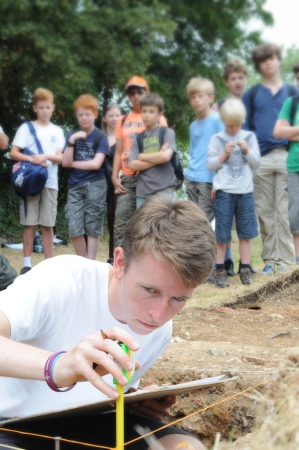A Summer of Digital Heritage at Basing House
Gareth Beale, Basing House Project Co-Director and Researcher at the Centre for Digital Heritage at the University of York talks about how the work of the Basing House Project fits into contemporary themes in Digital Heritage research. For more information about Digital Heritage or to find out what Gareth does for the rest of the year visit the CDH website or Blog.
As always the Basing House fieldwork season was an intense, exciting and extremely busy few weeks. In this post I want to take the time to tell you a little bit about the project and some of the ways in which working across and between disciplines and organisations has helped to produce a unique research environment.
The Basing House Project is a collaborative research project involving staff, students and volunteers and involves The University of York, The University of Southampton, Hampshire County Council and Basingstoke Archaeological and Historical Society. Each year a team of professionals, volunteers, researchers and students come together for four weeks to investigate a demolished 16th Century Tudor Palace using a wide variety of methods and techniques. The goal of the project is to build our understanding of the changes which have taken place in this place during the past thousand years. In order to achieve this we place an emphasis on the use of new technologies and approaches which can help us to better understand and better explain the history of the site.
Digital Recording
One of the initiatives at the heart of Basing House has been the use and development of digital documentation techniques for archaeological recording. This year we have been experimenting with a new documentation strategy which blends 3D photogrammetric recording with conventional single context recording. The benefit of recording in this way is that the resulting archive contains the interpretations and insights of field archaeologists alongside 3D interactive records of the archaeology as it progressed. This builds upon work previously undertaken which has sought to extract 3D data from photographic slides captured during excavations on the site during the 1960s.
We have a lot of very useful data, the challenge during the coming year will be to develop new methods for presenting these data and making them accessible to researchers and the public.
This year we also continued to use photographic techniques including RTI and near infra red photography to document and interpret archaeological materials. One of our student volunteers Vicki Man began an RTI survey of historical graffiti at the local parish church (a key site in the siege of Basing House in 1645) and we also began to use infrared photography to look for traces of paint on the surviving stonework from the house.
New Perspectives
It is always useful to see things with a fresh pair of eyes. At Basing House we work closely with artists and illustrators to get a unique perspective on the site and on the archaeological process. Archaeologists are trained to document things in particular ways. Standardised archaeological recording helps to ensure that the records we produce can be understood now and in the future. People with different training tend to see things differently, images, objects and digital data can help us to see the archaeology in new ways. What’s more, these unique records can help us to question the way in which we record things. They help us to be creative and to consider new ways of doing things.

Civil War pamphlets with a contemporary twist help us to tell the story of our project and how it relates to the past of the site.
Social Networking Platforms
Our communication strategy is central to what we do. Not everybody wants to read an archaeological report or wait for it to be written. By blogging and using social networking platforms such as Facebook we are able to keep the world informed on a moment by moment basis. This helps people who are unable to visit the site to keep up with our activities. It also means that people who do visit the site can find out what we are doing before they arrive. This year a lot of our volunteers found out about the dig while it was happening and came along to see if they could be involved.
This blog provides a public record of our activities. It is possible to look back over past seasons and see what we did and what it looked like. As the project continues this will increasingly be an important historical record.
These are just some examples of the work which we have been doing at Basing House. We hope that they help to show the some of the ways in which working with people, technologies and ideas from outside of your own discipline can help us to creatively engage with the research process and reach new audiences. If you have ideas of your own or would like to be involved in the project then feel free to get in touch by email or through our blog.
Filed under: Uncategorized




